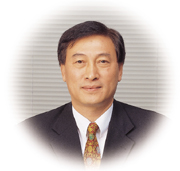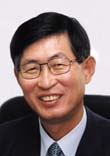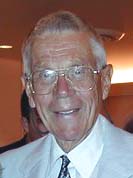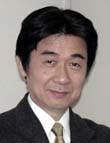|
|
|
Plenary sessions are schedule from 09:00
to 10:30 daily, starting on Sunday, August 1, 2004. They will be held in the
Ballroom of Ritz-Carlton Hotel, Seoul
Keynote speeches are presented at the
plenaries as listed below: |
| |
|
Plenary - 1:
Sunday, August 1, 2004 |
|
Chair: |
Dr. Timothy Anderson, Dept. of Engineering and Technology
Management, Portland State University, USA |
| |
 |
T.B.A |
|
| |
| |
"From Fast Follower to Innovation
Leader : Next Generation Innovation Model of Korea" |
| |
Speaker: Youngrak Choi,
Science & Technology Policy Institute, Korea |
| |
|
| |
There is no doubt that Korea
has been successful with its fast follower strategy based on learning skills
and manufacturing technology. Korea has shown remarkable successes in the
areas such as automobiles, memory chips, CDMA and so on. However, the
follower strategy would not work well where the capability of
architecture-design is the most critical competitive factor in the world
market. Now, the important sources of value are fundamental technologies,
parts and materials, and S/W. As Korea wants to move forward, it seeks to
establish a next-generation innovation model for the new growth. To realize
the innovation-driven growth, it is essential for Korea to lead the world
market by creating and utilizing fundamental technologies, leading global
standards, making high value-added products, and participating at global
sourcing system. In order to make these things happen in current Korean
innovation environment, it has to develop world-class manpower, to have more
innovative SMEs, and to establish innovative cross-teams among industry,
academia, research institutes. The emphases of new model will be: from
production/process technology to architecture-design capability, from
skilled manpower to creative manpower, and from the promotion of R&D actors
to innovative cross-teams. After all, it has to have self-changing dynamics
and adapt itself for the changing global innovation system. |
| |
|
| |
 |
Dr. Youngrak Choi is
the president of STEPI (Science & Technology Policy Institute) in S.
Korea. He is the President of the Korean Society for Technology
Management & Economics, and a member of the Presidential Advisory
Council for Science & Technology. |
|
| |
|
| |
"Positive Relationship Between Public
and Private R&D Expenditures of Korean Manufacturing" |
| |
Speaker: Hwan-Eik Cho, KOTEF, Korea |
| |
|
| |
The recent trend in Korean
R&D is that both private and public sector have extended their R&D
investments to achieve national income of $ 20,000. The Korean manufacturing
industry has invested 2.51% of their sales on R&D and made innovation of the
product and process. According to the latest survey of KOTEF, about 16.1% of
the total R&D expenditures among surveyed firms are covered with the public
R&D fund, which has various positive effects on the private sector : i) it
has induced an increase in the R&D investment of the private sector; ii) the
government R&D expenditure is analyzed to have the positive effect on the
private R&D expenditure, rather than the crowding-out effect; iii)
furthermore, public R&D expenditure has the positive effect on the
technology accumulation, employment, and reduction of R&D process. |
| |
|
| |

|
In 2002, Mr. Cho, as
the President, began representing Korea Industrial Technology
Foundation(KOTEF), which is a public service organization to help
establishing networks and upgrading the existing relationship among
industrial, economic and technological organizations throughout Korea.
He had been working at the Ministry of Commerce, Industry and Energy (MOCIE)
for 28 years. Throughout his government career as Deputy Minister of
Industry and Technology of MOCIE, he had planned and implemented various
industrial technology policies at national level and contributed to the
development of modern Korean industries. He also maintains a wide
international human network in the field of industrial technology
policy. Now, he has been working to utilize his past experiences in
forging and strengthening international cooperation with overseas
organizations in S&T field. |
|
|
|
|
Plenary - 2:
Monday, August 2, 2004 |
|
Chair: |
Dr. Kwan Rim,
Chairman, SAIT (Samsung Advanced Institute of Technology) |
|

|
Dr. Kwan Rim is the
Chairman of Samsung Advanced Institute of Technology (SAIT), the central
research laboratory of the Samsung Group. He received his M.S. in
Mechanical Engineering in 1958 and Ph.D. in Theoretical and Applied
Mechanics in 1960, both from Northwestern University in the USA.
In 1960 he joined the Department of Mechanics and Hydraulics of the
University of Iowa and was an engineering faculty member there until
1995. At the University of Iowa he was Chairman of the Department of
Mechanics and Hydraulics (1971-74), Associate Dean of Engineering
(1974-79), Chairman of the Division of Materials Engineering (1978-84),
and Chairman of the Department of Biomedical Engineering (1984-90). He
is the founder of the Biomedical Engineering Program at Iowa as well as
the Iowa Institute of Biomedical Engineering.
Dr. Rim held the U.S. National Science Foundation’s SEED (Scientists and
Engineers for Economic Development) Professorship in 1976-77, served as
the President of the Korea Advanced Institute of Science and Technology
(KAIST) from 1982 to 1984, and as a visiting professor in Japan in 1992.
He has also served on the boards of directors of numerous educational
and research institutes. He was the 1992 recipient of the Outstanding
Biomedical Engineering Educator Award from the American Society for
Engineering Education. He also served on the President’s Council on
Science and Technology of the Republic of Korea. |
|
|
|
|
Speaker: Seiichi Watanabe, Sony Corporation, Japan
|
| |
|
The prevailing Internet with the broadband
accessibility is opening up great opportunities in the consumer
industry as well as in the business. In this revolutionary
transformation, the traditional operating functions such as
production, sales, distribution etc. seem to become increasingly
commoditized owing to the speedy information access and sharing. Under
such environment, the R&D side would be expected to take initiatives
in creating major corporate values and thus opening the promising
future for the corporation.
The joint study at JATES (Japan Techno-Economics Society) has aimed
for discovering formulas to apply to those who wish to take advantage
of such a change and let their R&D teams revitalize the company. The
conclusion of the Study includes proposals to the top management to
allow strong autonomy to R&D for taking initiatives.
Many of the new business creations and resulting growth at Sony have
been driven by technological innovation. How such innovation has been
managed to create revolutionary success for the company would be
informative to those who wish to turn R&D value to major corporate
values in this rapidly changing business environment.
|
| |

|
Seiichi Watanabe
is Executive Vice President at Sony and has been responsible for
Environmental Affairs since 2001. He also holds the position of
President of Institute for Environmental Research (IER) at Sony
Corporation. His focuses on improvement of environmental aspects of
the products and the business operations of the company so that they
can be kept at the expectation of stakeholders and promote the high
brand value. As President of IER, he searches for and invests in new
technological developments to fundamentally resolve the
environmental concerns associated with products and business
activities. He and his researchers also aim for creating
environmentally effective new businesses through development of new
business models.
At JATES (Japan Techno-Economics Society) he has represented Sony
Corporation since 1990 and now serves as Chairman of the Committee
for the Study on R&D Initiated Transformation of Investment
Structure and Corporate Value Creation. The study group consists of
representatives of major companies located in Japan and work for
generating formulas to be applied to member companies who wish to
take advantage of the rapidly changing business environment by
effectively managing technology under R&D initiatives.
His majoring field has been the semiconductor technology. In 1967 he
started his career at Sony as engineer responsible for development
of high frequency semiconductor devices. His experiences included
discrete devices, MOS LSI and compound semiconductor devices. Later
he served as President of Semiconductor Company at Sony from 1994 to
1998. Through the development of semiconductor devices and LSI, he
was involved in a number of business creations, which have made
major contribution to the growth of the company. The products he was
involved in include Compact Disc, Mini-disc, PlayStation 2, portable
video tape recorders, etc.
He was responsible for research and development at Sony as Director
of Research Center and President of Frontier Science Laboratories
from 1989 to 1993 and 1998 to 2001. He promoted many innovative
research works, which again have become key technologies for major
businesses of the company. Such works included materials and devices
for various semiconductor lasers, lithium ion rechargeable
batteries, magnetic recording technologies, etc. In 1990, he
organized a group dedicated to environmental research, which
triggered his involvement in environmental affairs.
He hopes that the management of technology will serve for turning
technological innovations into businesses successful economically as
well as environmentally. He stayed in Minnesota, U.S.A. from 1959 to
1960 as an American Field Service high school exchange student where
he experienced the importance of mutual understanding to overcome
the culture gaps. |
|
|
|
|
|
Plenary - 3:
Tuesday, August 3, 2004 |
|
Chair: |
Dr. Gunnar Hambraeus, Chairman
Scandinavia-Japan Sasakawa Foundation, and former chairman, Royal Academy of
Engineering Science, Sweden |
|

|
Dr. Gunnar Hambreaus
was born in 1919. He got MSc. from Uppsala University, M.Eng. S from
Royal Institute of Technology in Stockholm and Dr.Eng.S, hon. from
Chalmers Technical University in Gothenburg. He served as secretary in
the Swedish Technical Research Council from 1946 to 1953, as editor in
chief of the leading technical periodical in Sweden (Teknisk Tidskrift)
from 1953 to 1970 and later as the president of Swedich Technical Press
AB and finally as president and later chairman of the Royal Swedish
Academy of Engineering Sciences from 1971 to 1985. He worked for Swedish
industry as member and in some cases chairman in the Board of Directors
of some 20 leading Swedish companies e.g Volvo, Bofors, Pharmacia,
Hasselblad and others. Presently Dr. Hambreaus chairs the
Scandinavia-Japan Sasakawa Foundation and the Sweden-Algeria Mixed
Commission as well as some Price Juries. As a member of the Swedish
Royal Academy of Science he takes part in the election of Nobel
Laureates in Physics, Chemistry and Economics. He is member of many
learned societies and academies inside and outside Sweden. He is proud
to carry decorations from the Swedish King and his Parliament as well as
orders from Sweden, France, Germany, Japan, Spain and Australia. |
|
| |
|
| |
"Oriental Philosophy, Aesthetics and
Science and Technological Innovation" |
| |
Speaker:
Chun-Yen Chang, National Chiao Tung University, Taiwan |
| |
There is a huge cultural divide between the East
and the West. However, around 500 B.C., both regions created many brilliant
works of philosophy, art and literature.
Now, after more than 2500 years, the
developments of science and technology in the East and the West are also
deeply divided. In this presentation, the cultural factors accounting for
the different paths of scientific and technological development in the two
regions will be explained. Greater emphasis will be given to the cultural
context of the East.
Looking ahead, we can see that a Renaissance
made possible by merging Eastern and Western cultures is essential for the
future of the 21st Century. To create an open, liberal, innovative
university environment is therefore indispensable for building a unique
culture conducive to scientific and technological innovation, a new kind of
oriental society cultivated by an aesthetic, creative education system in
the universities.
Finally, using NCTU as a prime example, this
presentation will demonstrate how our universities can effectively promote
such a new culture and help advance science and technology in the 21st
century.
|
|

|
Dr. Chun-Yen Chang is
the President of National Chiao Tung University in Taiwan. He received
his BSEE degree from the National Chenk Kung University (NCKU), and MS
and Ph.D. degrees from the National Chiao Tung University (NCTU). Prior
to his current position, he served as a research fellow at Bell Labs, a
professor at NCKU, the dean of research, dean of engineering and dean of
Electrical Engineering and Computer Science at NCTU. He also was the
founding Director of National Nano-Device Labs in Taiwan. In addition to
his presidency at NCTU, Dr. Chang holds several other positions and
affiliations including Foreign Associate of the U.S. National Academy of
Engineering, member of Academia Sinica of the Republic of China,
National Chair Professor, National Policy Advisor to the Office of the
President of the Republic of China, and Science and Technology Advisor
to the Executive Yuan of the Republic of China. Dr. Chang started his
research on semiconductors in 1960, and established the first
Semiconductor Research Center in the R.O.C. in 1964. Later, he also
established the National Nano-Device Research Laboratory for
leading-edge research on nano devices. His research in semiconductor
devices and key inventions have made significant contributions to the
field. Among his major inventions are the method of low pressure MOCVD
using triethyl Gallium, Zn incorporation, boron penetration and
nitridation in silicon dioxide, and modulation doped-based transistor.
Dr. Chang has received 26 patents in the U.S. and in Taiwan and has
published over 300 papers. He is the author of the book Made by Taiwan,
promoting the idea of innovation and creativity for the future of Taiwan
as a world leader in technology |
|
| |
|
| |
"Key European
Policies for Innovation in the Knowledge Economy: An Overview" |
| |
Speaker: Rosalie
Zobel, European Commission, Belgium |
| |
Innovation is the cornerstone
of the Lisbon strategy, which was formulated by Europe's leaders in March
2000. Since then the European Commission has launched its 6th Framework
Programme for research with an ambitious goal to create a single market for
research in Europe. It has published a Green Paper on entrepreneurship and
has also launched a debate on ways and means to increase research spending
in Europe to 3% of GDP from its current level of near 2%.
The recent Commission
proposal for innovation policy is based on the "multidimensional view" of
innovation. Besides research as a key driver for innovation and the need for
higher spending on R&D, new ways of organising work and new concepts in
design and marketing are key factors. Innovation policy must also provide
the skills and develop the motivation for entrepreneurialism. And it needs
to have an impact on the immediate operating environments of businesses. The
large size of the public sector in Europe's economy is a further
distinguishing feature. Under its eEurope policy framework, the EU aims to
help public authorities provide services online. The enlarged Union with ten
new member countries joining in May 2004 is a major and quite unique
challenge. The acceding countries have shown a remarkable capacity to
transform their economies, and this is a good sign that they will contribute
to a more innovative European Union.
The paper analyses what
innovation could mean in the context of the knowledge economy and society,
it draws attention to several factors that have an influence on innovation,
in addition to research. And it also maps out the "new deal" for innovation
policy, including concrete proposals made so far, to turn Europe's diversity
into a powerful impetus for innovation and economic growth.
|
| |

|
Rosalie A. Zobel was
born in England. She received a bachelor's degree in physics from
Nottingham University, UK, in 1964, and a PhD in radiation physics from
London University in 1967. She started her career in the Information
Technology industry in ICL in 1967, and later held positions as a
systems engineer in CERN (Centre Européen pour la Recherche Nucléaire),
Geneva, Switzerland, the Atomic Energy Research Establishment, Harwell,
UK, and the Max-Planck Institut für Plasmaphysik, Garching, Germany. At
the latter she became operations manager of the first CRAY Supercomputer
centre in continental Europe. In 1981 she moved to the USA and took up a
position in the AT&T Headquarters, Basking Ridge, USA. She held
positions as senior marketing manager for open systems software both for
the USA and international markets, and was responsible from 1983-1986
for the international UNIX business. In 1986 she became senior marketing
manager for information technology products in AT&T Japan. She returned
to Europe in 1988 as Deputy Head of Unit of the European Community's
ESPRIT Business Systems unit. In 1991 she launched the initiative in
Open Microprocessor systems (OMI). From 1995 she was the Head of unit
"Business systems, multimedia and microprocessor applications", and EU-coordinator
of the G7 Pilot Project "Global Marketplace for SMEs". From 1999-2002
she was Director of “New Methods of Work and Electronic Commerce”. From
2003 she is Director of "Components, Subsystems and Applications" in the
Information Society Directorate-General of the European Commission. |
|
| |
|
|
Plenary - 4: Wednesday, August 4, 2004 |
|
Chair: |
Dr.
Kiyoshi Niwa, Department of General Systems Studies, The University of
Tokyo, Japan |
| |

|
Kiyoshi Niwa is a
Professor in the Department of General Systems Studies at the University
of Tokyo. Before joining the university, he was with the Advanced
Research Laboratory (1985 to 1994) and the Systems Development
Laboratory (1972 to 1985), both of Hitachi, Ltd., Japan. Since 1988 he
also has been a Senior Research Fellow in the IC2 (Innovation Creativity
and Capital) Institute at the University of Texas at Austin, USA. From
1989 to 1991 he was a Visiting Professor of Engineering Management
Program at Portland State University, USA. His research and teaching
interests include technology & research management, knowledge
management, and organizational intelligence. He has published many
papers in journals such as IEEE Transactions on Engineering Management;
IEEE Transactions on Systems, Man, and Cybernetics; AI Magazine;
Knowledge Engineering Review; and the Journal of the Japan Society for
Management Information. He is the author of the book Knowledge-Based
Risk Management in Engineering (Wiley Series in Engineering and
Technology Management) published by John Wiley in 1989, and is a
co-editor of PICMET '91, '97, '99, and '01. He is also the co-author of
the book Technology Management Strategy (in Japanese), published by
Seisansei-shuppan in Tokyo in 1999, which was translated into Korean in
2001. Dr. Niwa received his BS (1970) and MS (1972) in chemistry
(physical chemistry) from Waseda University, Japan. While working as a
research scientist at Hitachi, he received his Dr. of Engineering (1986)
in systems science (knowledge management) from the Tokyo Institute of
Technology, Japan. He serves as the editor of the Journal of the Japan
Society for Management Information and on the editorial boards of IEEE
Transactions on Engineering Management, Knowledge Engineering Review,
and The International Journal of Decision Support Systems. He is the
PICMET Director of International Activities. |
|
| |
|
| |
"Development
of Large Complex Systems Based on Axiomatic Design and Complexity Theory" |
| |
Speaker:
Nam P. Suh, MIT, United States |
| |
In industry, it is well known that it is
extremely difficult to predict the cost and the schedule of complex
product development, the reliability and performance of resulting
engineering systems, and the economic impact of making major changes to
complex systems. All of these difficulties may be attributed to the ad hoc
nature of current engineering and development practice, which often
involves a lengthy recursive “design/build/test” cycle until the product
satisfies its functional requirements. The unpredictability and
unreliability of the product development process erodes the
competitiveness of industrial firms, especially when a product is being
developed for the first time.
In this keynote paper, a strategy for the systematic development of new
complex products will be presented. This strategy, which is based on
axiomatic design theory and complexity theory, provides a structured way
of developing new products and processes that significantly reduces the
cost and time necessary for product development. It also increases the
reliability of products developed and allows systematic modifications of
products and processes. The theoretical framework for the strategy will be
briefly introduced, followed by examples of innovative product
development.
|
| |

|
Positions Held at MIT:
Associate Professor of Mechanical Engineering, 1970-1975; Director, MlT-Industry
Polymer Processing Program 1973-1984; Professor of Mechanical
Engineering, 1975-Present; Director, Laboratory for Manufacturing and
Productivity, 1977-1984; Cross Professor, 1989-Present; Director,
Manufacturing Institute, 1990-Present; Department Head,
1991-2001;.....[Non-MIT Positions Held:] National Science Foundation,
1984-1988, (Assistant Director for Engineering, Presidential Appointee);
University of South Carolina, 1965-69 (Assist./ Assoc. Professor); USM
Corporation, 1961-65; Guild Plastics, 1958-60 Honors and Awards: Gustus
L. Larson Memorial Award, Pi Tau Sigma and ASME, 1976; Election to CIRP,
1978; Citation Classic of ISI, 1979; Best Paper Award of SPE, 1981;
Blackall Award of ASME, 1982; Who's Who in America; Honorary D Eng.
Worcester Polytechnic Institute, 1986; The F.W. Taylor Research Award,
SME, 1986; Fellow, ASME 1987; Federal Engineer of the Year, NSPE, 1987;
Distinguished Service Award, NSF 1987; Honorary LHD, University of
Mass., 1988; Foreign Member, Royal Swedish Academy of Engineering
Science, 1988; Centennial Medallion Award, ASEE, 1993; The Ennor
Manufacturing Technology Award, ASME, 1993; The KBS Award for Scholarly
Achievements, 1995; Korean Academy of Science and Technology Life
Member, 1995; The 1997 Ho-Am Prize for Engineering, Ho-Am Foundation,
1997; Honorary Doctor (Tekn. Hedersdoktor), Royal Institute of
Technology, Sweden, 2000; The Mensforth International Gold Medal, The
Institution of Electrical Engineers, United Kingdom, March 15, 2001; The
Hills Millennium Award of the Institution of Engineering Designers of
the United Kingdom (First recipient), June 4, 2001. |
|
| |
|
| |
"Technology
Roadmapping - Linking Technology Resources to Business" |
| |
Speaker:
Robert Phaal, University of Cambridge, United
Kingdom |
| |
The technology roadmapping technique is used
widely in industry to support strategic technology planning. Roadmaps can
take various forms, but the most flexible and generic type comprises a
multi-layered time-based chart that links technology and product
developments to market needs. In recent years the approach has been used
in sector-level foresight programmes in North America, Asia and Europe.
This presentation will provide an overview of the technology roadmapping
approach, focusing on the development and application of a process for
supporting the rapid initiation of the technique in organisations. The
application of the method will illustrated by means of an automotive
sector-level case study (the UK Foresight Vehicle technology roadmapping
initiative), which highlights issues associated with customisation of the
roadmapping approach, and the related communication and network
development benefits.
|
| |

|
Robert Phaal joined
the Centre for Technology Management at Cambridge University in 1997,
and is currently engaged in a research programme to investigate
strategic technology management issues in business. The particular focus
of the research project is how to link technology resources to company
objectives, in order to develop a set of practical and well-founded
tools to support technology strategy and planning initiatives in the
firm. Outputs include a guide for supporting 'fast-start' technology
roadmapping, supported by a tool catalogue. Robert has a background in
mechanical engineering, consulting and contract research. |
|
| |
|
|

